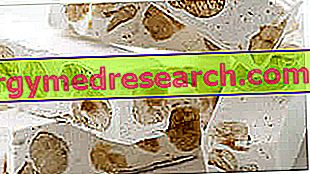Generality
Dolicocolon is an abnormality of the gastrointestinal tract, characterized by the presence of a colon longer than normal .
The dolicocolon can have a congenital nature - that is to be present from birth - or acquired, that is to appear in the course of life following a specific event or lifestyle.

In general, an accurate diagnosis of dolicocolon requires: physical examination, medical history, abdominal radiography and colonoscopy.
The treatment of dolicocolon depends mainly on the severity of the symptoms: if the symptoms are mild, a conservative treatment is sufficient, aimed above all at counteracting constipation; if instead the symptoms are very severe, and strongly affect the quality of life of the patient, it is necessary to resort to surgery, in order to restore the normal anatomy of the colon.
Brief reference to the anatomy of the intestine
The intestine is the portion of the digestive system between the pylorus and the anal orifice.
The anatomists divide it into two main sectors: the small intestine, also called small intestine, and the large intestine, also called large intestine .
- The small intestine is the first section; it starts at the level of the pyloric valve, which separates it from the stomach, and ends at the level of the ileocecal valve, located on the border of the large intestine. The small intestine consists of three sections (the duodenum, the jejunum and the ileum ), is about 7 meters long and has an average diameter of 4 centimeters.
- The large intestine is the terminal tract of the intestine and of the digestive system. It starts from the ileocecal valve and ends at the anus; consists of 6 sections ( cecum, ascending colon, transverse colon, descending colon, sigma and rectum ), is about 2 meters long and has an average diameter of 7 centimeters (hence the name of large intestine).
What is dolicocolon?
Dolicocolon is the medical term that indicates the presence of an abnormally long colon, that is, of a colon whose length exceeds the usual, physiological length.
The dolicocolon should not be confused with another anatomical anomaly of the colon, called megacolon, which consists of a dilation beyond the norm of a part or the entire colon.
Which part of the colon strikes the most?
Dolicocolon most frequently affects the descending colon and the sigmoid colon.
Origin of the name
The term "dolicocolon" derives from the union of two Greek words, which are: dolichon and colon . The word " dolichon " means "stretched", "elongated", while the word " colon " refers to the tract of intestine which, in Italian, takes the same name.
Therefore, the literal meaning of dolicocolon is " elongated colon ".
Causes
Dolicocolon can be a congenital condition - that is, present from birth - or acquired, that is, developed over a lifetime.
Causes of congenital dolicocolon
Based on the results of research conducted to date, congenital dolicocolon could depend on:
- Hereditary factors. There are inherited diseases characterized by the presence of anatomical abnormalities in the gastrointestinal tract; one of these anomalies is the dolicocolon;
- Viral diseases, contracted by the mother and then transmitted to the fetus, during pregnancy;
- The exposure of the mother to toxic substances (eg: pesticides), during pregnancy.
Causes of acquired dolicocolon
The acquired dolicocolon may depend on well definable causes or it may have an idiopathic nature (in medicine, a condition is called idiopathic when its trigger is unknown, not recognizable).
The possible causes of acquired dolicocolons include:
- A sudden and excessive weight loss, thanks to a very strict diet;
- An excessively sedentary lifestyle;
- A very strict vegetarianism;
- Different metabolic diseases in people of advanced age;
- The abuse of enemas;
- The myxedema. It is an edema with subcutaneous site, typical of severe hypothyroidism and some forms of hyperthyroidism, which occurs due to an accumulation of mucopolysaccharides in the dermis;
- Intoxications from substances such as lead or morphine.
Risk factors
As regards congenital dolicocolon, they are risk factors of this condition:
- The presence of some hereditary abnormalities of the gastrointestinal tract in one or both parents of the future unborn child;
- The development of some particular viral infections, by the mother during the 9 months of pregnancy;
- The exposure of the mother, during pregnancy, to some specific toxic substances.
Moving on to the risk factors of the acquired dolicocolon, these include:
- A sedentary lifestyle;
- Hard vegetarianism;
- The frequent recourse to enemas;
- Failure to treat a severe form of hypothyroidism.
Symptoms, signs and complications
Dolicocolon can be an asymptomatic condition - that is, free of associated disorders - or symptomatic - that is responsible for a certain symptomatic picture.
The typical symptoms of symptomatic dolicocolon consist of:
- Chronic constipation (or constipation). It is most likely the most important symptom;
- Abdominal pain and / or stomach pain;
- Abdominal swelling;
- Loud bowel sounds.
Characteristics of the constipation of the acquired dolicocolon
Initially, the acquired dolicocolon causes short periods of constipation (maximum 3-4 days). Over time, however, his negative influence on defecation capacity becomes more and more pronounced, to the point that patients suffer from constipation for several consecutive weeks.
Complications
The presence of dolicocolon favors the onset of a condition known as volvulus or intestinal volvulus, in which an intestinal tract is the protagonist of an abnormal twist on itself.
Volvulus is a phenomenon of significant clinical interest, as it can degenerate into two sometimes deadly complications for those affected; such complications are intestinal blockage (or intestinal obstruction ) and the severe reduction of blood supply to the tract of bowel subject to torsion ( intestinal ischemia ).
Why are intestinal blockage and intestinal ischemia very dangerous?
Intestinal blockage and intestinal ischemia are potentially very dangerous for those who are affected, because, from the first, serious bleeding and intestinal perforation episodes with consequent infections of the peritoneum can result, while, from the second, necrosis of the intestine section may depend on of ischemia.
OTHER COMPLICATIONS
In addition to volvulus, other possible complications of dolicocolon are all the potential consequences of prolonged constipation, namely: fecaloma, coprostasis, anal fissure, hemorrhoids and rectal prolapse.
Diagnosis
In general, the diagnosis of dolicocolon requires:
- A thorough physical examination and a careful medical history . They typically represent the first step of the diagnostic path. They allow the doctor to know and evaluate the symptoms, and get an idea of what the causes could be, based also on the lifestyle led by the patient (eg: diet, level of physical activity practiced etc.);
- X-ray of the abdomen . It is usually the first deepening of what emerged from the physical examination and from the anamnesis. It allows the doctor to view the internal organs of the abdomen and outline the state of health with a certain precision.
On the radiograph of the abdomen, an anomaly like the dolicocolon is easily recognizable.
- Colonoscopy . It is the diagnostic examination of exploration from inside the large intestine, through an instrument - the colonoscope - equipped with a camera and a light, and connected to an external monitor, which is used by the doctor to observe what is recorded by the camera.
Obviously, the introduction of the colonoscope into the large intestine occurs at the level of the anal opening.
- Abdominal ultrasound . It is used when the patient is a very young subject (eg: newborn or small child) and, for the information provided, represents an alternative exam to abdominal radiography.
Diagnosis of asymptomatic cases
The diagnosis of asymptomatic cases of dolicocolon is very often the result of chance. In fact, many people with an unusual lengthening of the colon discover that they are carriers of this anomaly during a colonoscopy or a radiograph of the abdomen performed for other reasons.
Differential diagnosis
There are several medical conditions that, due to a very similar symptomatology (constipation in particular), could be confused for dolicocolon; one of these medical conditions is Hirschsprung's disease .
Also known as congenital megacolon, Hirschsprung's disease is a congenital anomaly, characterized by the absence of nerve endings that control the smooth muscle of the colon necessary for the proper development of intestinal peristalsis.
To distinguish dolicocolon from Hirschsprung's disease, if there were clearly doubts, doctors resort to so-called anorectal manometry, a diagnostic test that evaluates the pressure and contractility of the anal sphincter and rectal ampulla.
Contrary to what happens in the dolicocolon, in Hirschsprung's disease the contractility of the rectal sphincter, evidenced through anorectal manometry, is seriously compromised and it is this compromise that represents the element that distinguishes the two conditions in question.
Curiosity
Hirschsprung's disease is one of the main causes of intestinal blockage in newborns.
Therapy
The dolicocolon requires the planning of a specific therapy only when it is symptomatic; the absence of a symptomatology, therefore, excludes the necessity to resort to particular cures.
What is therapy planning based on?
Doctors plan the treatment of dolicocolon based on the severity of the symptoms and how far the affected colon is extended beyond the norm.
In general, when the symptoms are mild and the dolicocolon is contained, the treatment is conservative, whereas when the symptoms are severe and the dolicocolon is a clinically relevant condition, the treatment is surgical.
Conservative treatments
Among the conservative treatments of dolicocolon, above all remedies against constipation fall, therefore:
- The adoption of a dietary regime with a high fiber content (whole grains, fruit, vegetables, legumes, etc.);
- Daily intake of at least 2 liters of water;
- Regular practice of physical activity;
- The consumption of lactic ferments;
- Consumption of algae and dietary fiber supplements;
- The use of laxatives. These are indicated when the previous remedies are not very effective.
The conservative treatment does not act on the anatomical anomaly of the colon (which remains), but on the symptomatology.
Surgical treatment
Surgery is reserved for the most complex cases of dolicocolon, which do not improve with conservative treatment and / or degenerate into complications.
Surgical treatment for dolicocolon consists of an operation of resection of the colon, in order to restore the normal anatomy of the large intestine.
The surgical technique used to perform the above procedure can be laparotomy (very invasive) or laparoscopy (minimally invasive).
Prevention
The possibility of preventing dolicocolon exists only when the latter is an acquired condition.
Once this point has been clarified, one of the main preventive rules of the acquired dolicocolon deserve a special mention: follow a healthy and balanced diet, lose weight (when necessary) following the instructions of a nutritionist, regularly practice physical activity and adequately treat any metabolic diseases.
Prognosis
If the treatment is adequate and timely, most cases of dolicocolon have a positive prognosis.



